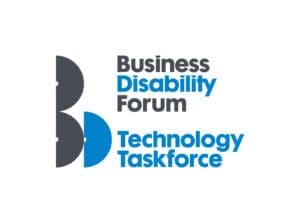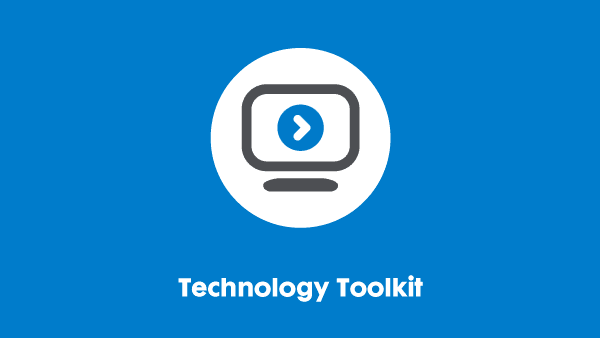Last updated: 16 June 2025
The Accessible Technology Charter
This resource was created by our Technology Taskforce, a group of senior IT accessibility individuals from leading UK and global organisations. For more information, including how to join, see our website.

Introduction
Why would you want to sign up to the Accessible Technology Charter and what benefits can it bring to you and your organisation?
This guide will talk you through the process of signing up to the Charter, the commitment that you are making and how it will help you to embed accessibility into your organisation.
What is the Accessible Technology Charter?
The Accessible Technology Charter sets out ten commitments to good practice on digital accessibility. Signing up is a public declaration by an organisation that it will make ten commitments on accessibility as part of its technology strategy, including having an executive Champion, and developing and buying accessible systems.
In November 2011, we (the Technology Taskforce) launched the Accessible Technology Charter which sets out ten commitments to good practice on digital accessibility. We agreed and developed the ten points of this Charter as representing good practice in ensuring the accessibility of any technologies used by our clients, customers and colleagues.
Signing the Charter does not mean committing to comply with each of the ten points from the date of signature. Instead, it is a commitment to work towards embedding the principles of each point in the normal business of the signatory organisation – to mainstream accessibility insofar as this is possible.
The wording of each clause is chosen to be applicable to as broad a range of organisations as possible. Therefore, it must be interpreted by each signatory organisation in the context of their own business dealings. It is intended to be interpreted using natural language, so we rely on organisations using common sense.
Business Disability Forum expects that the commitments will be adopted in good faith. As such, we will not adopt a restrictive interpretation of any clause, then criticise any organisation for perceived non-compliance. We recognise that business needs may make it impossible to achieve full accessibility, but we expect that such circumstances should be recognised and documented.
Why sign up to the Charter?
By understanding how accessibility works in numerous areas of your business and making a commitment to improve things, you will make it easier for you and your colleagues to assess where you are and make the necessary improvements.
Those that have signed up to the Charter have made a pledge that:
“We will ensure people living with a disability or who acquire a disability can apply for jobs with us, be employed by us, and do business with us, by implementing an inclusive technology strategy which includes the following commitments to accessibility.”
You can find out more about the ten commitments of the Charter and you can also see a list of the organisation that have already signed up to the Charter.
Although you will not be monitored against your Charter commitment, this isn’t something that you should take lightly. This should be signed off by your senior digital leader, Chief Information Officer (CIO) or Chief Technology Officer (CTO). It is their responsibility to ensure that all aspects of the Charter are embedded within your business.
If your organisation would like to explore signature but you need further information, please contact us at technology@businessdisabilityforum.org.uk.
What current signatories say
Paul Smyth, Head of Digital Services at Barclays
“Back in 2012, Barclays recognised the growing need for accessible services and reached out to external experts such as Business Disability Forum to understand where to start and what best practices from other disability confident organisations were.
“Accessible technology was a huge enabler for Barclays and the BDF’s Accessible Technology Charter that we signed represented a public pledge and a vehicle to keep us honest across the key dimensions that matter most in delivering digital services that work for all customers and colleagues.
“Since then, the Accessible Technology Charter has acted as our north star in constantly and consciously reviewing the progress we’re making over time and against peers by making use of the Accessibility Maturity Model – created by and for leading organisations who are active in disability inclusion.
“These tools and charter provide a structured and systematic approach to measure and report our performance to senior leaders over time but equally important is the need to continue collaborating with other BDF organisations who share our ambition in removing barriers, improving lives and unlocking human potential.”
Enterprise’s EU Director Jeff King
“Enterprise Rent-A-Car is thrilled to sign the Accessible Technology Charter. We are committed to the aims of the Charter, and we are very happy to be in good company with prominent organisations who have already signed.
“At Enterprise, we place a high level of importance on developing a diverse workforce, serving a diverse customer base and working with a diverse set of suppliers. We recognise that if our technology is more accommodating to people with disabilities, we are also creating a better experience for all users.
“While this is simply the right thing to do, there is also a tremendous commercial advantage to getting this right”.
When should I sign up to the Charter?
We get many questions from accessibility leads about the right time for an organisation to sign up the Charter.
The answer is that it will be different for each organisation. By signing up to the Charter, you are not saying that all your work is done in this area – if this were the case, we probably wouldn’t have any signatories!
This is a public commitment to try to get things right, not to say that you are there and you have done it all. For some organisations that have been addressing their accessibility issues for a number of years, they can find that by getting senior support and signing up to the Charter, this can give them the support that they need to make the next steps. For others, it can be useful and provide them with a strong structure to work within, if they sign up when they are in the early stages of accessibility maturity.
You may also find it useful to look at our guidance on the roles of accessibility Champions and Sponsors.
How do I sign up to the Charter?
Once you and your organisation have decided that you are ready to sign up to the Charter, the process is quite simple.
- Download the Word document [DOCX, 79.63 KB] and add your organisations logo, along with the signature of your senior technology lead (CIO/CTO etc) and send it back to technology@businessdisabilityforum.org.uk.
- Once we have your signed copy, we can send you out a logo that you can use on any publicity, email footers etc, to say that you have signed up to the Charter.
We always like to publicise when we have a new signatory, so we may ask you for a quote to use in social media and in our newsletter.
I’ve signed up, so what next?
Technology resources
Signing up to the Accessible Technology Charter is only one step in improving your accessibility, the most important part is to embed it. We have created a number of resources, available on our website. These include best practice guides and case studies. These have all been designed to make it easier for you to understand ‘what good looks like’ and practical guidance on how best to achieve this.
You may also want to publicise that you are a Charter signatory and use the logo provided in your email footer or on your website.
The Accessibility Maturity Model
We also have a self-assessment tool – the Accessibility Maturity Model (AMM) – available for you to use.
This will help you to identify the areas where you may need improvement. This a tool to help you assess where you are and how you can look to improve your accessibility within your organisation.
The Charter is about making the commitment and the AMM is about measuring how well you are doing against the commitment and they both include the same 10 areas of commitment. We would recommend that you review your AMM scores at least annually, although this could be more often.
Further information
Signing up to the Accessible Technology Charter is only the starting point. Once you’ve done this, there is always more that you can do. If you want to get in touch and find out more about how to join the Technology Taskforce, please email us at technology@businessdisabilityforum.org.uk.
Current signatories
- AbilityNet
- Accenture
- AMS
- Atos
- AvePoint
- Barclays
- BATA
- BCS – The Chartered Institute for IT
- BT
- Bupa
- CGI
- Cisco
- CYFOR
- David Berman Communications
- de Poel
- Department for Environment, Food & Rural Affairs
- Department for Work & Pensions
- Digital Accessibility Centre
- DiversityJobs.co.uk
- Enabled City
- Enterprise Rent-A-Car
- EY
- Foreign, Commonwealth & Development Office
- Fujitsu
- GlaxoSmithKline
- Greater London Authority
- Hassell Inclusion
- Hex Productions
- HM Revenue & Customs
- Home Office
- HowDoI?
- iansyst
- KPMG
- Lexxic
- Lilly
- Lloyds Banking Group
- Microlink
- Microsoft
- Ministry of Defence
- National Crime Agency
- NatWest Group
- NeateBox
- Numbers Factory
- Office for National Statistics
- Oracle
- PwC
- Royal Mail
- Sainsbury’s
- Scope
- Shell
- Sky
- Standard Chartered
- Texthelp
- UNiDAYS
- University of Exeter.
If you require this content in a different format, contact enquiries@businessdisabilityforum.org.uk.
© This resource and the information contained therein are subject to copyright and remain the property of the Business Disability Forum. They are for reference only and must not be copied or distributed without prior permission.
